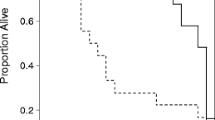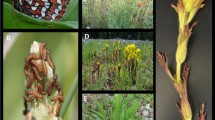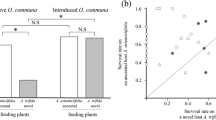Abstract
Exotic plants may act as population sinks or evolutionary traps for native herbivores. The native butterfly Pieris oleracea lays eggs on garlic mustard, Alliaria petiolata, but larvae develop very poorly on this exotic invasive plant. We examined oviposition preference of individual females and larval performance of their offspring for individuals from one area where garlic mustard is well established and one where it is absent. These data were used to assess whether garlic mustard is being incorporated into or excluded from the diet. Females from the area without garlic mustard showed a wide range of preference, families had low larval survival on garlic mustard, and larval survivorship showed no correlation with mothers’ preferences. Females from the area with garlic mustard preferred it to the native host, and larval survivorship on garlic mustard was positively correlated with the mother’s preference. Individuals surviving on garlic mustard took longer to pupate and weighed >30% less compared to pupae reared on normal hosts. Our results suggest that where garlic mustard is well established P. oleracea may be adapting to this plant by both improved larval performance and increased adult female oviposition preference for it.


Similar content being viewed by others
References
Anderson RC, Kelley TC, Dhillion SS (1996) Aspects of the ecology of an invasive plant, garlic mustard (Alliaria petiolata) in central Illinois. Restor Ecol 4:181–191
Benson J, Van Driesche RG, Pasquale A, Elkinton J (2003) Introduced braconid parasitoids and range reduction of a native butterfly in New England. Biol Control 28:197–213
Berdegue M, Reitz SR, Trumble JT (1998) Host plant selection and development in Spodoptera exigua: do mother and offspring know best? Entomol Exp Appl 89:57–64
Berenbaum MR, Zangerl AR (1994) Costs of inducible defense: protein limitation, growth, and detoxification in parsnip webworms. Ecology 75:2311–2317
Bergstrom A, Nylin S, Nygren GH (2004) Conservative resource utilization in the common blue butterfly—evidence for low costs of accepting absent host plants? Oikos 107:345–351
Bernays E (1999) Plasticity and the problem of choice in food selection. Annu Rev Entomol Soc Am 92:944–951
Bernays E, Graham M (1988) On the evolution of host specificity in phytophagous arthropods. Ecology 59:886–892
Berube, DE (1972) Behavioral and physiological adaptation in the evolution of foodplant specificity in a species complex of Colias butterflies. PhD dissertation, Yale University, New Haven
Blossey B, Nuzzo V, Hinz H, Gerber E (2001) Developing biological control of Alliaria petiolata (M. Bieb.) Cavara and Grande (garlic mustard). Nat Areas J 21:357–367
Boggs CL, Niell RS, Shaw F, Ezenwa VO, Simmers S, White K, Leidner AK (2008) Introduced host and native herbivore: a case of maladaptation (in press)
Bossart JL (2003) Covariance of preference and performance on normal and novel hosts in a locally monophagous and locally polyphagous butterfly population. Oecologia 135:477–486
Bossart JL, Scriber JM (1995) Maintenance of ecologically significant genetic variation in the tiger swallowtail butterfly through differential selection and gene flow. Evolution 49:1163–1171
Bossart JL, Scriber JM (1999) Preference variation in the polyphagous tiger swallowtail butterfly (Lepidoptera: Papilionidae). Environ Entomol 28:628–637
Bowden SR (1971) American white butterflies (Pieridae) and English food-plants. J Lepidopt Soc 25:6–12
Bowers MD, Stamp NE, Collinge SK (1992) Early stage of host range expansion by a specialist herbivore, Euphydryas phaeton (Nymphalidae). Ecology 73:526–536
Camara MD (1997) A recent host range expansion in Junonia coenia Hubner (Nymphaliedae): oviposition preference, survival, growth, and chemical defense. Evolution 51:873–884
Casagrande RA, Dacey JE (2007) Monarch butterfly oviposition on swallow-worts (Vincetoxicum spp.), Environ Entomol 36:631–636
Caubet Y, Jaisson P (1991) A post-eclosion early learning involved in host recognition by Dinarmus basalis Rondani (Hymenoptera: Pteromalidae). Anim Behav 58:977–980
Cavers PB, Heagy MI, Kokron RF (1979) The biology of Canadian weeds.35. Alliaria petiolata (M.Bieb.) Cavara and Grande. Can J Plant Sci 59:217–229
Charlesworth B, Coyne JA, Barton NH (1987) The relative rates of evolution of sex chromosomes and autosomes. Am Nat 130:113–146
Chew FS (1975) Coevolution of pierid butterflies and their cruciferous foodplants. I. The relative quality of available resources. Oecologia 20:117–127
Chew FS (1977) Coevolution of pierid butterflies and the cruciferous foodplants. II. The distribution of eggs of potential foodplants. Evolution 31:568–579
Chew FS (1980) Larval preferences of Pieris caterpillars (Lepidoptera). Oecologia 46:347–353
Chew FS (1981) Coexistence and local extinction in two pierid butterflies. Am Nat 118:655–672
Chew FS, Watt WB (2006) The green-veined white (Pieris napi L.), its pierine relatives, and the systematics dilemmas of divergent character sets (Lepidoptera: Pieridae). Biol J Linn Soc 88:413–435
Cipollini D, Gruner B (2007) Cyanide in the chemical arsenal of garlic mustard, Alliaria petiolata. J Chem Ecol 33:85–94
Courant AV (1996) The effect of a naturalized crucifer on the feeding ecology of Pieris napi oleracea and Pieris virginiensis (Lepidoptera: Pieridae). MS thesis biology. Tufts University, Medford
Courant AV, Holbrook AE, Van der Reijden ED, Chew FS (1994) Native pierine butterfly (Pieridae) adapting to naturalized crucifer. J Lepidopt Soc 48:168–170
Cuda JP, Parker PE, Coon BR, Vasquez FE, Harrison JM (2002) Evaluation of exotic Solanum spp. (Solnanales: Solanaceae) in Florida as host plants for the leaf beetles Leptinotarsa defecta and L. texana (Coleoptera: Chrysomelidae). Fla Entomol 85:599–610
Davis JM, Stamps JA (2004) The effect of natal experience on habitat preferences. Trends Ecol Evol 19:411–416
Dethier VG (1954) Evolution of feeding preferences in phytophagous insects. Evolution 8:33–54
DiTommaso A, Losey JE (2003) Oviposition preference and larval performance of monarch butterflies (Danaus plexippus) on two invasive swallow-wort species. Entomol Exp Appl 108:205–209
Feder JL, Reynolds K, Go W, Wang EC (1995) Intra- and interspecific competition and host race formation in the apple maggot fly, Rhagoletis pomonella (Diptera: Tephritidae). Oecologia 101:416–425
Feldman TS, Haber WA (1998) Oviposition behavior, host plant use, and diet breadth of Anthanassa butterflies (Lepidoptera: Nymphalidae) using plants in the Acanthaceae in Costa Rican community. Fla Entomol 81:396–406
Forister ML (2005) Independent inheritance of preference and performance in hybrids between host races of Mitoura butterflies (Lepidoptera: Lycaenidae). Evolution 59:1149–1155
Fox CW, Lalonde RG (1993) Host confusion and the evolution of insect diet breadths. Oikos 67:577–581
Futuyma DJ (1995) Genetic constraints on macroevolution: the evolution of host-affiliation in the leaf-beetle genus Ophraella. Evolution 49:797–809
Gilbert N (1984) Control of fecundity in Pieris rapae. I. The problem. J Anim Ecol 53:581–588
Gossard TW, Jones RE (1977) The effects of age and weather on egglaying in Pieris rapae (L.). J Appl Ecol 14:65–71
Gross J, Fatouros NE, Hilker M (2004) The significance of bottom-up effects for host plant specialization in Chrysomela leaf beetles. Oikos 105:368–376
Haggstrom H, Larsson S (1995) Slow larval growth on a suboptimal willow results in high predation mortality in the leaf beetle Galerucella lineola. Oecologia 104:308–315
Hämback PA, Beckerman AP (2003) Herbivory and plant resource competition: a review of two interacting interactions. Oikos 101:26–37
Haribal M, Yang Z, Attygalle AB, Renwick JAA, Meinwald J (2001) A cyanoallyl glucoside from Alliaria petiolata as a feeding deterrent for larvae of Pieris napi oleracea. J Nat Prod 64:440–443
Haukioja E, Neuvonen S (1985) Induced long-term resistance of birch foliage against defoliators: defensive or incidental? Ecology 66:1303–1308
Hopkins AD (1917) A discussion of H.G. Hewitt’s paper on ‘Insect behaviour’. J Econ Entomol 10:92–93
Hovanitz W, Chang VCS (1964) Adult oviposition responses in Pieris rapae. J Res Lepidopt 3:159–172
Hovanitz W, Chang VCS (1965) The alteration of host-plant specificity in larvae of Pieris rapae by induction. J Res Lepidopt 4:13–21
Huang XP, Renwick JAA, Chew FS (1995) Oviposition stimulants and deterrents control acceptance of Alliaria petiolata by Pieris rapae and P. napi oleracea. Chemoecology 5/6:79–87
IPANE: Invasive Plant Atlas of New England (2003) Department of Ecology and Evolutionary Biology, University of Connecticut, Storrs. http://www.ipane.org Cited 14 August 2006
Jaenike J (1978) On optimal oviposition behavior in phytophagous insects. Theor Popul Biol 14:350–356
Janz N (1998) Sex-linked inheritance of host-plant specialization in a polyphagous butterfly. Proc R Soc Lond Ser B Biol Sci 265:1675–1678
Janz N (2003) Sex linkage of host plant use in butterflies. In: Boggs CL, Watt WB, Ehrlich PR (eds) Butterflies: ecology and evolution taking flight. University of Chicago Press, Chicago, pp 229–239
Jones RE, Hart JR, Bull GD (1982) Temperature, size and egg production in the cabbage butterfly, Pieris rapae L. Aust J Zool 30:223–232
Joshi A, Thompson JN (1995) Trade-offs and the evolution of host specialization. Evol Ecol 9:82–92
Karowe DN (1990) Predicting host range evolution: colonization of Coronilla varia by Colias philodice. Evolution 44:1637–1647
Keeler MS, Chew FS, Goodale BC, Reed JM (2006) Modelling the impacts of two exotic invasive species on a native butterfly: top-down vs. bottom-up effects. J Anim Ecol 75:777–788
Klots AB (1951) A field guide to the butterflies of North America east of the Great Plains. Houghton Mifflin, Boston
Loader C, Damman H (1991) Nitrogen content of food plants and vulnerability of Pieris rapae to natural enemies. Ecology 72:1586–1590
Louda SM, Rand TA, Arnett AE, McClay AS, Shea K, McEachern AK (2005) Evaluation of ecological risk to populations of threatened plant from an invasive biocontrol insect. Ecol Appl 15:234–249
Mattila HR, Otis GW (2003) A comparison of the host preference of monarch butterflies (Danaus plexippus) for milkweed (Asclepias syriaca) over dog-strangler vine (Vincetoxicum rossicum). Entomol Exp Appl 107:193–199
Mayhew PJ (1997) Adaptive patterns of host-plant selection by phytophagous insects. Oikos 79:417–428
Mayhew PJ (2001) Herbivore host choice and optimal bad motherhood. Trends Ecol Evol 16:165–167
Mulatu B, Applebaum SW, Coll M (2004) A recently acquired host plant provides an oligophagous insect herbivore with enemy-free space. Oikos 107:231–238
Murphy SM (2004) Enemy-free space maintains swallowtail butterfly host shift. Proc Natl Acad Sci USA 101:18048–18052
Nitao JK, Ayres MP, Lederhouse RC, Scriber JM (1991) Larval adaptation to lauraceous hosts: geographic divergence in the spicebush swallowtail butterfly. Ecology 72:1428–1435
Nuzzo V (1993) Distribution and spread of the invasive biennial Alliaria petiolata (garlic mustard) in North America. In: McKnight BN (ed) Biological pollution, the control and impact of invasive exotic species. Indiana Academy of Sciences, Indianapolis, pp 137–145
Nylin S, Nygren GH, Windig JJ, Janz N, Bergstrom A (2005) Genetics of host-plant preference in the comma butterfly Polygonia c-album (Nymphalidae), and evolutionary implications. Biol J Linn Soc 84:755–765
Ohsaki N, Sato Y (1994) Food plant choice of Pieris butterflies as a trade-off between parasitoid avoidance and quality of plants. Ecology 75:59–68
Opler PA, Krizek GO (1984) Butterflies east of the Great Plains. Johns Hopkins University Press, Baltimore
Porter A (1994) Implications of introduced garlic mustard (Alliaria petiolata) in the habitat of Pieris virginiensis (Pieridae). J Lepidopt Soc 48:171–172
Rausher MD (1978) Search image for leaf shape in a butterfly. Science 200:1071–1073
Renwick JAA (2002) The chemical world of crucivores: lures, treats and traps. Entomol Exp Appl 104:35–42
Renwick JAA, Zhang WQ, Haribal M, Attygalle AB, Lopez KD (2001) Dual chemical barriers protect a plant against different larval stages of an insect. J Chem Ecol 27:1575–1583
Rodman JE, Chew FS (1980) Phytochemical correlates of herbivory in a community of native and naturalized Cruciferae. Biochem Syst Ecol 8:43–50
Rojas JC, Wyatt TD (1999) The role of pre- and post-imaginal experience in the host-finding and oviposition behaviour of the cabbage moth. Physiol Entomol 24:83–89
Schlaepfer MA, Sherman PW, Blossey B, Runge MC (2005) Introduced species as evolutionary traps. Ecol Lett 8:241–246
Sezer M, Butlin RK (1998) The genetic basis of oviposition preference differences between sympatric host races of the brown planthooper (Nilaparvata lugens). Proc R Soc Lond Ser B Biol Sci 265:2399–2405
Shapiro AM (1975) Developmental and phenotypic responses to photo-period in uni and bivoltine Pieris napi in California. Trans R Entomol Soc Lond 127:65–71
Sims SR (1980) Diapause dynamics and host plant suitability of Papilio zelicaon (Lepidoptera: Papilionidae). Am Midl Nat 103:373–384
Singer MC (1971) Evolution of food-plant preference in the butterfly Euphydryas editha. Evolution 25:383–389
Singer MC, Ng D, Thomas CD (1988) Heritability of oviposition preference and its relationship to offspring performance within a single insect population. Evolution 42:977–985
Stanton ML (1982) Searching in a patchy environment: foodplant selection by Colias p. eriphyle butterflies. Ecology 63:839–855
Tabashnik BE (1983) Host range evolution: the shift from native legume hosts to alfalfa by the butterfly, Colias philodice eriphyle. Evolution 37:150–162
Thomas CD, Ng D, Singer MC, Mallet JLB, Parmesan C, Billington HL (1987) Incorporation of a European weed into the diet of a North American herbivore. Evolution 41:892–901
Thompson JN (1988a) Evolutionary ecology of the relationship between oviposition preference and performance of offspring in phytophagous insects. Entomol Exp Appl 47:3–14
Thompson JN (1988b) Evolutionary genetics of oviposition preference in swallowtail butterflies. Evolution 42:1223–1234
Thompson JN, Pellmyr O (1991) Evolution of oviposition behavior and host preference in Lepidoptera. Annu Rev Entomol 36:65–89
Thompson JN, Wehling W, Podolsky R (1990) Evolutionary genetics of host use in swallowtail butterflies. Nature 344:148–150
Van der Reijden ED, Chew FS (1992) Assessing host-plant suitability in caterpillars: is the weight worth the wait? In: Mencken SB, Visser JH, Harrewijn P (eds) Proceedings of the 8th international symposium on insect–plant relationships. Kluwer, Dordrecht, pp 69–70
Van Driesche RG, Nunn C, Pasquale A (2004) Life history pattern, host plants, and habitat as determinants of population survival of Pieris napi oleracea interacting with an introduced braconid parasitoid. Biol Control 29:278–287
Welk E, Schubert K, Hoffman MH (2002) Present and potential distribution of invasive garlic mustard (Alliaria petiolata) in North America. Div Distrib 8:219–233
White DJ, Haber E, Keddy C (1993) Canadian museum of natural history. In: Invasive plants of natural habitats in Canada, Ottawa, p 121
Wiklund C (1984) Egg laying patterns in butterflies in relation to their phenology and the visual apparency of their host plants. Oecologia 63:23–29
Yamamoto M, Ohtani T (1979) Number of eggs laid by Pieris rapae crucivora, compared with P. napi nesis, in Sapporo (Lepidoptera: Pieridae). Kontyu 47:530–539
Zangerl AR, Huang T, McGovern JL, Berenbaum MR (2002) Paradoxical host shift by Depressaria pastinacella in North America: is enemy free space involved? Oikos 98:431–436
Acknowledgements
We thank the Urie family (Craftsbury, Vermont) for permission to collect on their land; Sheena Harris, Zoe Hastings, Mayu Uchihashi, and Richard Bryan for laboratory and field assistance; Ihsan Al-Shebaz for determining some species identifications; Bernd Blossey for correspondence about garlic mustard; Colin Orians for laboratory equipment; Carol Boggs for sharing unpublished results on P. napi macdunnoughii; Michael Reed, Durwood Marshall, and Sara Lewis for statistical assistance; Carol Boggs, Dick Casagrande, Ross Feldberg, Sara Lewis, Colin Orians, Jan A. Pechenik, Michael Reed, J. Alan A. Renwick, and two reviewers for improving the manuscript. We thank Tufts Institute for the Environment and the Arabis Fund for financial support. All collections of living material and experiments were done in compliance with current law, including permits for collection of Massachusetts threatened species, no. 024.05SCI.
Author information
Authors and Affiliations
Corresponding author
Additional information
Communicated by Craig Osenberg.
Rights and permissions
About this article
Cite this article
Keeler, M.S., Chew, F.S. Escaping an evolutionary trap: preference and performance of a native insect on an exotic invasive host. Oecologia 156, 559–568 (2008). https://doi.org/10.1007/s00442-008-1005-2
Received:
Accepted:
Published:
Issue Date:
DOI: https://doi.org/10.1007/s00442-008-1005-2




